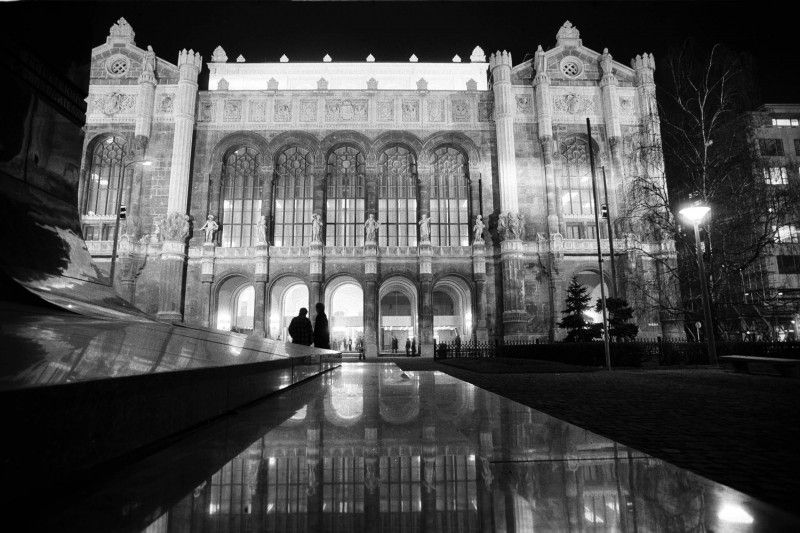In today’s Vigadó area, the XVIII. at the end of the century, there was a rondella protecting Pest from the north, which was demolished in 1789. They wanted to build a theater in its place, based on the plans of the court architect, Mihály Pollack, the designer of the National Museum, finally built the predecessor of the Vigadó.
It is one of the iconic buildings of Hungarian architecture
The building named Redoute, a masterpiece of Pest classicist architecture, was completed in 1832, the opening ball was held on January 13, 1833 with the participation of more than a thousand guests. Even after the opening, Pollack continued to deal with the fate of the building: he prepared reports on lighting and heating, developed service regulations to ensure that the building met the needs of the time.
Before the revolution and war of independence in 1848, the Redoute was the only concert hall in Pest, the charity concert organized after the great Pest flood of 1838 was held here, Ferenc Liszt performed here for the first time after the flood, and he was the first to play the Rákóczi indulo in the concert hall.
This was the site of the first People’s Representative Parliament during the revolution. On July 11, 1848, the representatives offered Kossuth’s famous speech in the concert hall 200,000 recruits and 42 million forints for the defense of the country – the building was therefore used as a fortress during the siege of Buda in May 1849. defender Field Marshal Hentzi shot it down in revenge.
József Hild was first entrusted with the reconstruction in 1852, but due to a lack of funds, the work did not even begin, and in 1859, Frigyes Feszl was asked to design the new Vigadó. At that time, the attention of the Viennese court was occupied by the Sard-French-Austrian war, and the construction work did not start until the following year. The building was opened with a grand ball on January 15, 1865, and the city officially took possession of it a month later.
Vigadó is the first building decorated with frescoes
At the time, Feszl’s work was not really liked by the public or professionals, but later it became a symbol of Hungarian romantic architecture. For a long time, the public in Pest referred to the building by its old name, Redoute, later it was mockingly called Vigarda, but in the end the name Vigadó became permanent.
Feszl wanted to decorate the interior walls of the building with mosaics, but the Pest city council decided in favor of paintings – Vigadó became the first public building in Pest to be decorated with frescoes. Károly Lotz and Than Mór painted the frescoes of the main staircase leading to the main hall on the upper floor and the side rooms at the two ends. The sculptures on the facade depict the greatest figures of Hungarian history, among others Zsigmond, IV. They depict Kings Béla, Louis I (the Great) and Matthias I, Queen Mária Theresia, István Széchenyi and János Hunyadi.
Sparkling cultural center
In a short time, the building became a popular center of Pest’s cultural life. Balls and receptions were also held in the concert hall, the monarch also participated in the ball organized in 1867 on the occasion of the coronation of Ferenc József I. The unification of Pest, Buda and Óbuda was celebrated here in 1873, i.e. the birth of Budapest, and at the concert organized on the fiftieth anniversary of the unification of the capital, works written for the occasion by Béla Bartók, Zoltán Kodály and Dohnányi were presented here.
Johann Strauss, Mascagni, Antonín Dvorák visited the Vigadó’s walls, the orchestra of the Budapest Philharmonic Society (Hungary’s oldest operating orchestra) often performed here, the pianists Ernő Dohnányi and Annie Fischer made their debuts here.
Johannes Brahms’ piano concerto in B-flat major was presented here in 1881, in which the German composer himself played the solo, and the orchestra was conducted by Sándor Erkel. A year later, in 1882, Puskás Tivadar presented for the first time the technology of Dalműtelefon, which transmitted opera performances over telephone lines, at the Vigadó journalists’ ball.

Reconstructions and reopenings
Vigadó was so badly damaged in 1945, during the siege of Budapest, that there was a debate about whether it should be restored.
In 1954, it was added to the list of monuments, and at the end of the 1950s, at the persistent demand of experts, its reconstruction was allowed (although the authorities repeatedly gave the example that schools could be built with the money).
The construction, or more precisely the reconstruction, began in 1968, the renewed Danube-side palace opened its doors again on March 12, 1980 with a theater hall for 660 and a theater for 200 people, as well as an exhibition gallery. The concert hall also gave space to important artists during this period, György Cziffra, Dénes Kovács, Eszter Perényi, Miklós Szenthelyi and Szvjatoslav Richter also performed here.
Vigadó, which retains only a trace of its old beauty, was closed in 2004, and a new renovation, taking into account historical aspects and striving to restore the original condition, began.
A Joyful the Hungarian Academy of Arts acquired its ownership in 2013, the doors of the building, which was expanded with new spaces, opened on March 14, 2014. The Makovecz room on the fourth floor, which is primarily used as a venue for smaller concerts and conferences, has a capacity of 150 people, and the Imre Sinkovits Chamber Stage, created for theater productions, has a capacity of 165 people.
Source: magyarnemzet.hu


